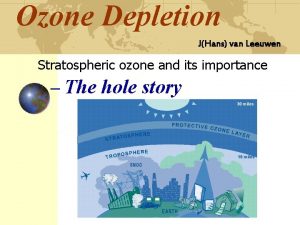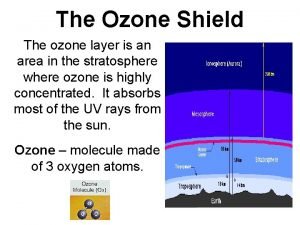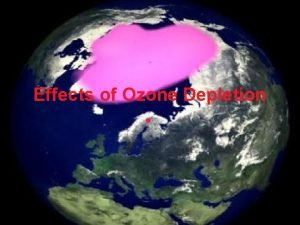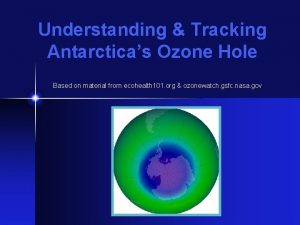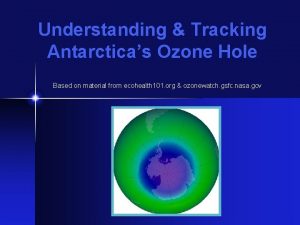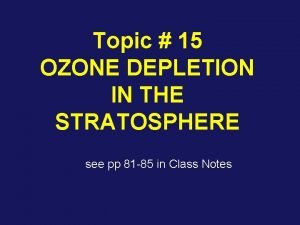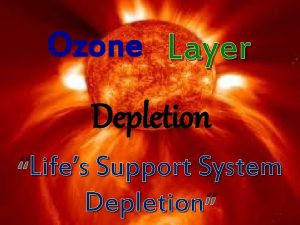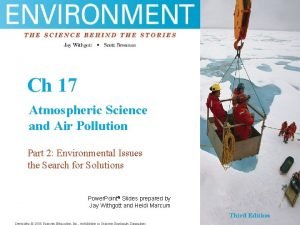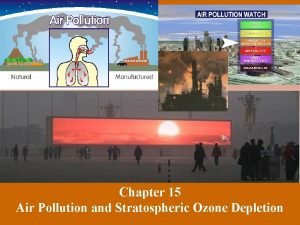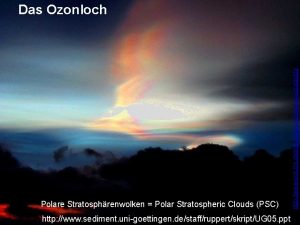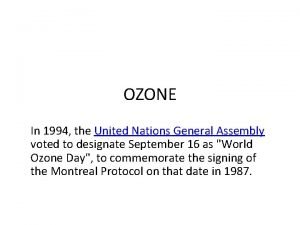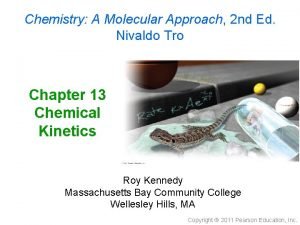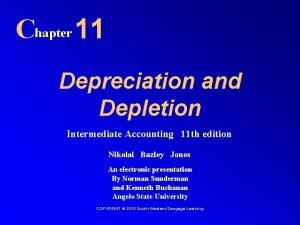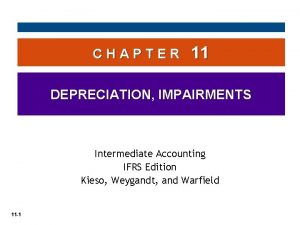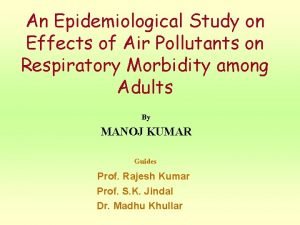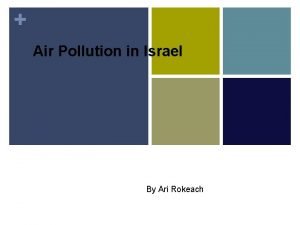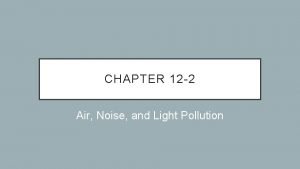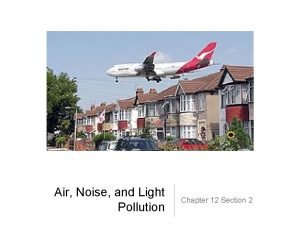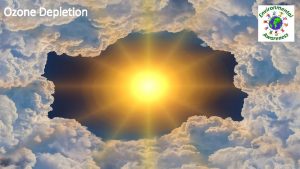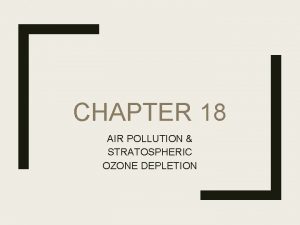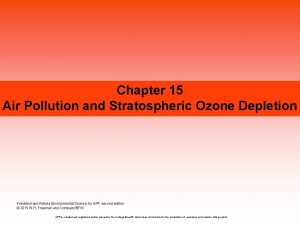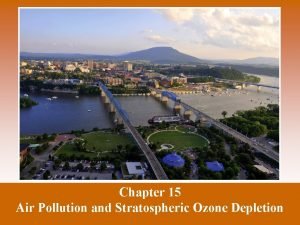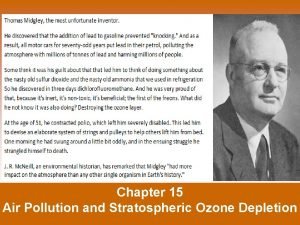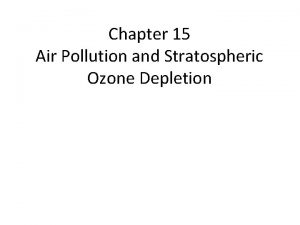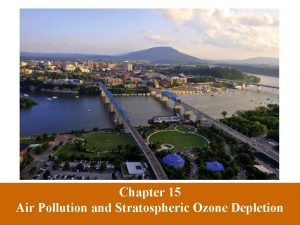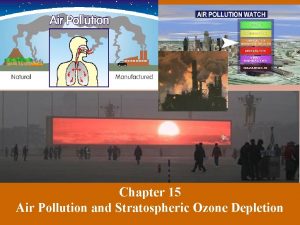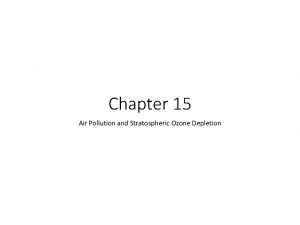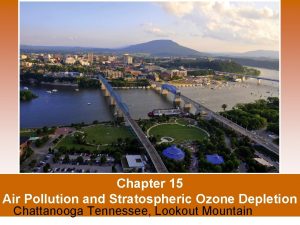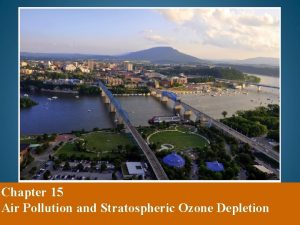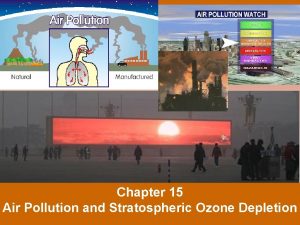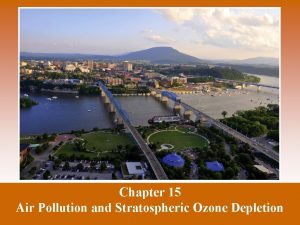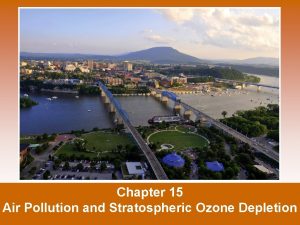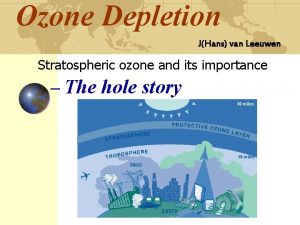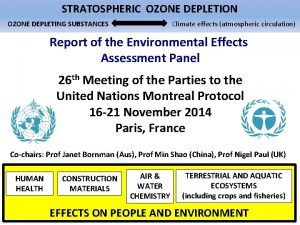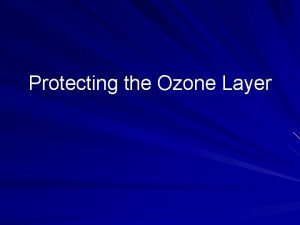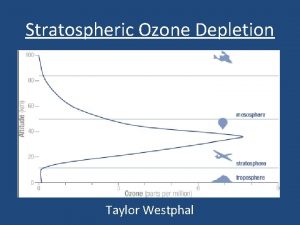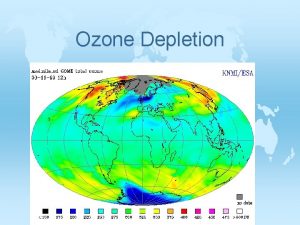Chapter 15 Air Pollution and Stratospheric Ozone Depletion



























- Slides: 27

Chapter 15 Air Pollution and Stratospheric Ozone Depletion

Air Pollution © Air pollution- the introduction of chemicals, particulate matter, or microorganisms into the atmosphere at concentrations high enough to harm plants, animals, and materials such as buildings, or to alter ecosystems. © Typically refers to the troposphere.

Major Air Pollutants © Sulfur Dioxide © Nitrogen Oxides © Carbon Oxides © Particulate Matter © Volatiles Organic Compounds © Ozone © Lead © Mercury



Primary Pollutants © Primary pollutants- polluting compounds that come directly out of the smoke-stack, exhaust pip, or natural emission source. © Examples: CO, CO 2, SO 2, NOx, and most suspended particulate matter.

Secondary Pollutants © Secondary pollutants- pollutants that have undergone transformation in the presence of sunlight, water, oxygen, or other compounds. © Examples: ozone, sulfate and nitrate

Natural Sources of Air Pollution © Volcanoes © Lightning © Forest fires © Plants

Anthropogenic Sources of Air Pollution © On-road vehicles © Power plants © Industrial processes © Waste disposal


Photochemical Smog

Thermal Inversions © Thermal Inversion- when a relatively warm layer of air at mid-altitude covers a layer of cold, dense air below. © The warm inversion layer traps emissions that then accumulate beneath it.


Acid Deposition

Acid Deposition © Acid deposition- occurs when nitrogen oxides and sulfur oxides are released into the atmosphere and combine with atmospheric oxygen and water. These form the secondary pollutants nitric acid and sulfuric acid. © These secondary pollutants further break down into nitrate and sulfate which cause the acid in acid deposition.

Effects of Acid Deposition © Lowering the p. H of lake water © Decreasing species diversity of aquatic organisms © Mobilizing metals that are found in soils and releasing these into surface waters © Damaging statues, monuments, and buildings

Ways to Prevent Air Pollution © Removing sulfur dioxide from coal by fluidized bed combustion © Catalytic converters on cars © Scrubbers on smoke stacks © Baghouse filters © Electrostatic precipitators




Stratospheric Ozone © The stratospheric ozone layer exists roughly 45 -60 kilometers above the Earth. © Ozone has the ability to absorb ultraviolet radiation and protect life on Earth.

Formation and Breakdown of Ozone © First, UV-C radiation breaks the bonds holding together the oxygen molecule O 2, leaving two free oxygen atoms: O 2 + UV -C -> 2 O © Sometimes the free oxygen atoms result in ozone: + O -> O 3 © Ozone is broken down into O 2 and free oxygen atoms when it absorbs both UV-C and UV-B ultraviolet light: O 3 + UV-B or UV-C -> O 2 + O O 2

Anthropogenic Contributions to Ozone Destruction © Certain chemicals can break down ozone, particularly chlorine. © The major source of chlorine in the stratosphere is a compound known as chlorofluorocarbons (CFCs) © CFCs are used in refrigeration and air conditioning, as propellants in aerosol cans and as “blowing agents” to inject air into foam products like Styrofoam.

Anthropogenic Contributions to Ozone Destruction © When CFCs are released into the troposphere they make their way to the stratosphere. © The ultraviolet radiation present has enough energy to break the bond connecting chlorine to the CFC molecule. © which can then break apart the ozone molecules.

Anthropogenic Contributions to Ozone Destruction © First, chlorine breaks ozone’s bonds and pulls off one atom of oxygen, forming a chlorine monoxide molecule and O 2: O 3 + Cl -> Cl. O + O 2 © Next, a free oxygen atoms pulls the oxygen atom from Cl. O, liberating the chlorine and creating one oxygen molecule: Cl. O + O -> Cl + O 2 © One chlorine atom can catalyze the breakdown of as many as 100, 000 ozone molecules before it leaves the stratosphere.

Depletion of the Ozone Layer © Global Ozone concentrations had decreased by more than 10%. © Depletion was greatest at the poles © Decreased stratospheric ozone has increased the amount of UV-B radiation that reaches the surface of Earth.

Indoor Air Pollutants © Wood, animal manure or coal used for cooking and heating in developing countries. © Asbestos © Carbon Monoxide © Radon © VOCs in home products
 Stratospheric ozone depletion
Stratospheric ozone depletion Ozone depletion negative effects
Ozone depletion negative effects Ozone layer depletion effects on humans
Ozone layer depletion effects on humans Causes of the ozone depletion
Causes of the ozone depletion Ozone layer depletion introduction
Ozone layer depletion introduction Ozone depletion diagram
Ozone depletion diagram Cause of ozone depletion
Cause of ozone depletion Ozone layer depletion
Ozone layer depletion Copyright
Copyright How is smog formed
How is smog formed Chapter 12 section 3 acid precipitation
Chapter 12 section 3 acid precipitation Chapter 12 air section 1 what causes air pollution
Chapter 12 air section 1 what causes air pollution Polar stratospheric clouds
Polar stratospheric clouds Polar stratospheric clouds
Polar stratospheric clouds Polar stratospheric clouds
Polar stratospheric clouds Stratospheric balloon
Stratospheric balloon Chapter 11 depreciation
Chapter 11 depreciation Carrying amount formula
Carrying amount formula Kunci jawaban buku intermediate accounting ifrs chapter 11
Kunci jawaban buku intermediate accounting ifrs chapter 11 Air higroskopis air kapiler dan air gravitasi
Air higroskopis air kapiler dan air gravitasi 2 causes of land pollution
2 causes of land pollution Land water and air pollution
Land water and air pollution Aims of air pollution
Aims of air pollution Difference between secondary and primary pollutants
Difference between secondary and primary pollutants Stationary and mobile sources of air pollution
Stationary and mobile sources of air pollution Aim and objectives of air pollution
Aim and objectives of air pollution Air noise and light pollution
Air noise and light pollution Section 2 air noise and light pollution
Section 2 air noise and light pollution
